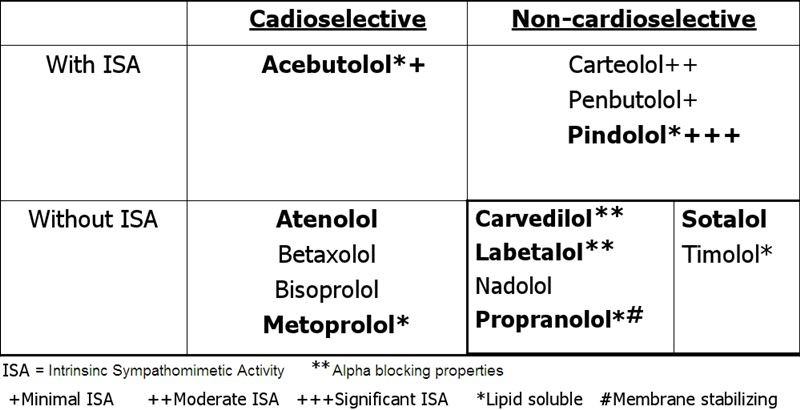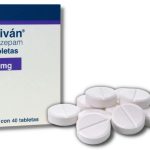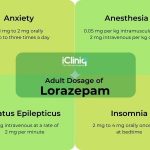
Contents
Metoprolol vs. Labetalol
Metoprolol is a beta-adrenergic blocking agent (beta-blocker) that treats high blood pressure (hypertension), angina, congestive heart failure, abnormal heart rhythms, hyperthyroidism, and some neurologic conditions. It also prevents migraine headaches.
Labetalol, another beta-blocker, is used to treat high blood pressure. It blocks adrenergic receptors on arteries, causing them to expand and lowering blood pressure.
Side effects of metoprolol and labetalol
Metoprolol
Metoprolol may cause:
- Abdominal cramps
- Diarrhea
- Constipation
- Fatigue
- Insomnia
- Indigestion
- Nausea
- Depression
- Dreaming
- Memory loss
- Fever
- Impotence
- Lightheadedness
- Low blood pressure
- Decreased exercise tolerance
- Increased triglycerides
- Bronchospasm
- Cold extremities
- Sore throat
- Shortness of breath or wheezing
Serious adverse effects may include:
- Slow heart rate
- Raynaud’s phenomenon
- Hepatitis
- Increased insulin resistance
Metoprolol may worsen breathing difficulties in patients with asthma, chronic bronchitis, or emphysema.
WARNING: Metoprolol can cause dangerously slow heart rates and worsen heart failure symptoms in patients with existing heart conditions. Stopping metoprolol abruptly can worsen angina and occasionally cause heart attacks. High-dose metoprolol before non-cardiac surgery is associated with adverse effects. Consult a physician before discontinuing metoprolol.
Labetalol
The most common side effects of labetalol are:
Postural hypotension may occur rarely. Patients should be monitored within two to four hours of the initial dose and after any changes in dose.
Other important side effects include:
- Sexual dysfunction
- Abnormal heart rhythm
- Slow heart rate
- Liver failure
- Allergic reactions
Dosage of metoprolol vs. labetalol
Metoprolol
- Metoprolol should be taken before meals or at bedtime.
- The dosage for hypertension is 100 to 450 mg daily in single or divided doses.
- The dosage for angina is 100 to 400 mg daily in two divided doses.
- The dosage for heart attack is three 5 mg injections administered 2 minutes apart, followed by 50 mg oral metoprolol every 6 hours for 48 hours. After 48 hours, patients should receive 100 mg orally twice daily for at least 3 months.
- The dosage for congestive heart failure is 25 mg daily initially, with gradual increases every 2 weeks to reach a target dose of 200 mg daily orally.
- The dosage for hyperthyroidism is 25 to 30 mg by mouth every 6 hours.
Labetalol
- The recommended starting oral dose of labetalol is 100 mg twice daily. The dose may be increased by 100 mg twice daily every 2 to 3 days based on blood pressure response. Usual maintenance doses are 200 to 400 mg twice daily. Patients with severely high blood pressure may require 1.2 to 2.4 g daily.
- Side effects may be reduced with three daily doses of labetalol instead of two. Stopping or changing the dose of labetalol should be done under the guidance of a physician due to potential serious side effects. The initial intravenous dose is 20 mg injected over 2 minutes. Additional injections of 40 or 80 mg may be administered every 10 minutes as needed up to a total dose of 300 mg. Labetalol can also be given by intravenous infusion at a rate of 1 to 2 mg/minute.
Drug interactions with metoprolol and labetalol
Metoprolol
- Calcium channel blockers and digoxin (Lanoxin) can dangerously lower blood pressure and heart rate when taken with metoprolol.
- Metoprolol can mask the early warning symptoms of low blood sugar and should be used cautiously in patients with diabetes.
- Fluoxetine (Prozac) can increase blood levels of metoprolol, intensifying its side effects.
Labetalol
- Labetalol can mask early warning symptoms of hypoglycemia in diabetes patients, so blood sugar monitoring should be increased.
- Combining labetalol with tricyclic antidepressants may increase tremors.
- Adrenergic stimulating drugs used to treat asthma may have reduced effectiveness when combined with labetalol.
- Glutethimide may decrease labetalol’s effectiveness.
- Cimetidine may increase labetalol’s effectiveness.
- Halothane anesthesia may contribute to the blood pressure lowering effects of labetalol.
By clicking "Submit," I agree to the MedicineNet Terms and Conditions and Privacy Policy. I also agree to receive emails from MedicineNet and understand that I may opt out of subscriptions at any time.
Safety of metoprolol and labetalol during pregnancy or breastfeeding
Metoprolol
- Safe use of metoprolol during pregnancy has not been established.
- Small quantities of metoprolol are excreted in breast milk and may potentially harm the infant.
Labetalol
- There are no adequate studies of labetalol during pregnancy.
- Labetalol is excreted in human breast milk, and caution is advised for nursing mothers due to the risk of slow heart rate in infants.


